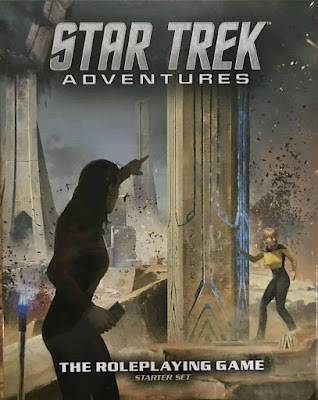I’m on a study project to improve my understanding of roleplaying games. To this end, I already have two reading projects, A Game Per Year and An Adventure Per Year. This is the third, with the goal of reading or playing 52 games made in the last few years. Originally I considered making this “A New RPG Per Week” and that’s where the number 52 comes from, even though a weekly schedule is probably not within my abilities.

I find starter sets interesting to read because there’s a surprisingly large variation in what gets prioritized, how broad the experience portrayed is and what’s understood to be beginner friendly. In the Starter Set published for Star Trek Adventures, the focus is squarely on teaching mechanics and task resolution, with freestyle character-based social roleplaying relegated so far into the background as to render it invisible.
The set consists of a rules booklet, a few tactical maps of different situations arising in the scenario, the scenario booklet, character tokens and readymade character sheets. The written characters consist of stats accompanied by minimalist gestures towards personality.
There’s a distinct advantage in gearing the set so precisely towards a simple playable experience. The players and the GM can get going quickly with as little preparation needed as possible. There are three playable scenarios forming a mini-campaign based on the Star Trek: The Next Generation episode Conspiracy. The characters and the starship provided function within the limits of this campaign, with no need for life beyond it.
There are some interesting design choices in the presentation and the game itself. The booklets feature decorative infographics in the style of TNG, with no concrete informational substance. They look broadly the same as the actual tables, creating for some visual confusion.
The Prime Directive is a Star Trek classic. It’s accompanied by mission-specific Directives that guide how players are to approach a given scenario. For example, a Directive can stress the need for nonviolent solutions.
The mini-campaign ends with a classic TNG ethical quandary, without a good simple answer. That’s good stuff, obviously fodder for an interesting moral discussion.